Some ovulation and implantation symptoms overlap. Find out how to tell them apart, with advice from a Flo expert.
-
Tracking cycle
-
Getting pregnant
-
Pregnancy
-
Help Center
-
Flo for Partners
-
Anonymous Mode
-
Flo app reviews
-
Flo Premium New
-
Secret Chats New
-
Symptom Checker New
-
Your cycle
-
Health 360°
-
Getting pregnant
-
Pregnancy
-
Being a mom
-
LGBTQ+
-
Quizzes
-
Ovulation calculator
-
hCG calculator
-
Pregnancy test calculator
-
Menstrual cycle calculator
-
Period calculator
-
Implantation calculator
-
Pregnancy weeks to months calculator
-
Pregnancy due date calculator
-
IVF and FET due date calculator
-
Due date calculator by ultrasound
-
Medical Affairs
-
Science & Research
-
Pass It On Project New
-
Privacy Portal
-
Press Center
-
Flo Accuracy
-
Careers
-
Contact Us
Ovulation vs. implantation: How to tell the difference
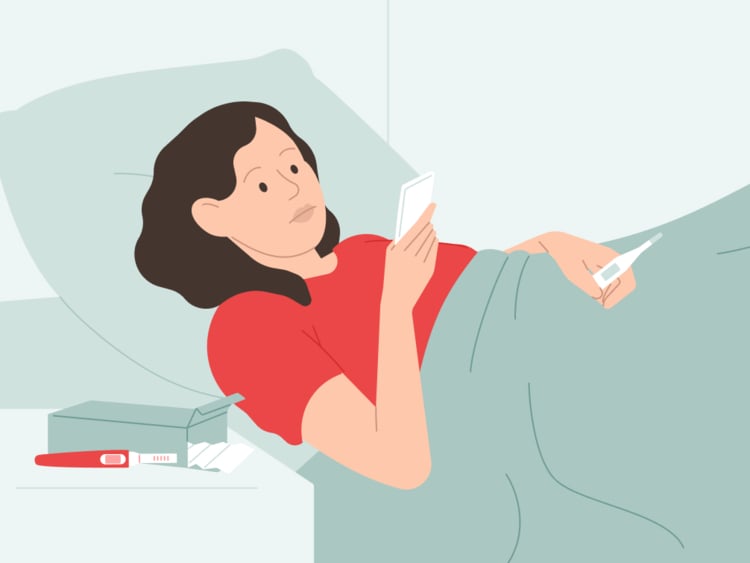

Every piece of content at Flo Health adheres to the highest editorial standards for language, style, and medical accuracy. To learn what we do to deliver the best health and lifestyle insights to you, check out our content review principles.
When you’re trying for a baby, it’s natural to be on high alert for any signs of what’s going on in your body.
You might be especially attentive to signs of ovulation (when you’re at your most fertile) and implantation (the moment when you officially become pregnant). But confusingly, these two milestones can have similar symptoms. Here’s the lowdown on how to spot the difference between ovulation and implantation.
Key takeaways
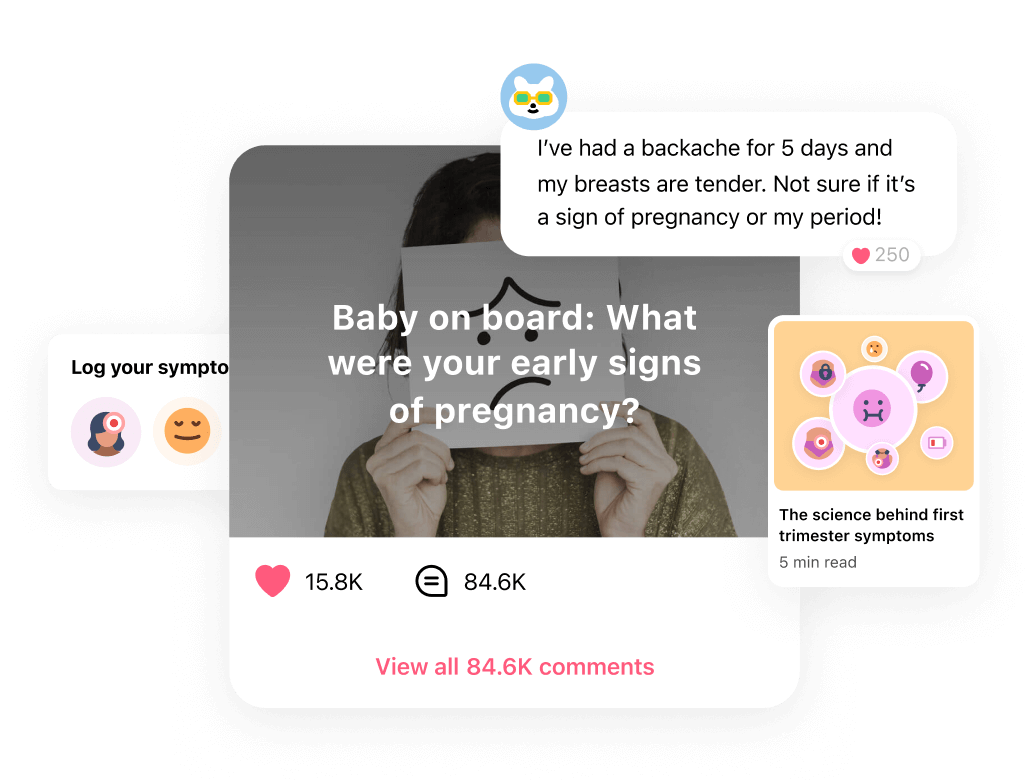
 Over
7.8M
ratings averaging
4.8/5
*
Over
7.8M
ratings averaging
4.8/5
*
Understand your body’s signals with the Flo app
- Chat with others who are trying to get pregnant.
- Get trusted information on signs of pregnancy from 100+ medical experts.
- Log your symptoms and learn what they could be trying to tell you.
 Over
7.8M
ratings averaging
4.8/5
*
Over
7.8M
ratings averaging
4.8/5
*
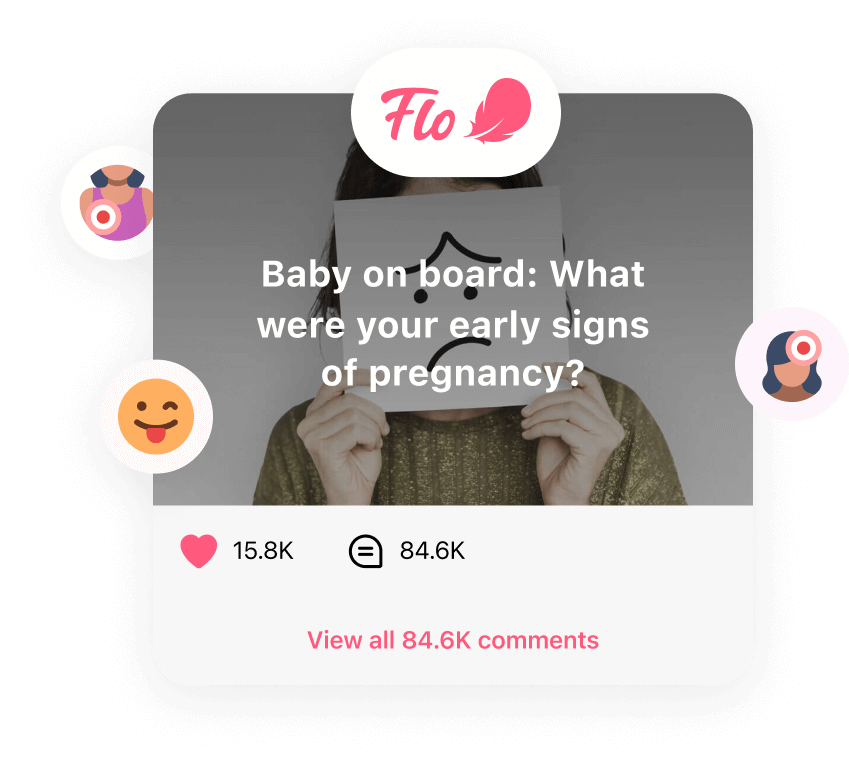
Trying to conceive?
The Flo app can help you through the two-week wait.

 Over
7.8M
ratings averaging
4.8/5
*
Over
7.8M
ratings averaging
4.8/5
*
Understand your body’s signals with the Flo app
- Chat with others who are trying to get pregnant.
- Get trusted information on signs of pregnancy from 100+ medical experts.
- Log your symptoms and learn what they could be trying to tell you.
- There are a number of different symptoms of ovulation, though not everyone experiences them. Some of the most common signs are wet, slippery vaginal discharge, tender breasts, light bleeding or spotting, and cramps.
- The key signs of implantation are just light bleeding or spotting and cramps — and only a quarter of women experience them. So knowing if implantation has happened can be really tough.
- The best way to tell the difference between ovulation and implantation is through the timing of the symptoms. Ovulation usually happens 14 days before your next period, whereas implantation usually happens six to 10 days after ovulation. This means any symptoms of implantation you experience may be closer toward the time you’d expect your period to arrive. And to be extra sure, take a pregnancy test the day after a missed period.
Ovulation vs. implantation: What’s the difference?
If you’re trying to get pregnant, ovulation and implantation may be two milestones on your mind. However, they’re very different. Ovulation is when your body releases an egg so that it can get fertilized by a sperm. This is the time in your cycle when you’re most fertile. To be more precise, your fertile window includes the five days before ovulation, the day of ovulation, and the 24 hours after. When you’re trying to conceive, these are the best days to have sex to conceive.
Implantation, on the other hand, comes later. After ovulation, if a sperm meets and fertilizes your egg, it may travel down your uterine tube to your uterus, where it may attach to the uterine lining. This is the moment when you become officially pregnant.
What are the signs of implantation vs. ovulation?
To understand how to spot implantation versus ovulation, it’s good to know some of the signs of both.
Ovulation symptoms
Around the time you ovulate, you might feel slightly different. Ovulation can come with many different symptoms, but it’s important to know that different people experience different signs, and not everyone feels them. The most common signs are:
- Wet, slippery vaginal discharge that looks a bit like raw egg whites
- Tender breasts
- Abdominal pain (ovulation pain, also known as “mittelschmerz”)
- Light bleeding or spotting: “This can appear pink and typically only lasts for one day,” says Dr. Jenna Flanagan, academic generalist obstetrician and gynecologist, Beth Israel Deaconess Medical Center, Massachusetts, US.
- Bloating
- Increased sex drive
- Heightened senses, including smell, taste, or sight
- Mood changes
- Appetite changes
- A slight increase in your basal body temperature: This is your temperature when you’re resting.
Implantation symptoms
Implantation comes with far fewer signs than ovulation. In fact, according to one study from the United States, on average, people don’t realize that implantation has happened and that they are pregnant until they are 5.5 weeks along.
There are really only two possible signs of implantation itself, according to Dr. Flanagan:
- Light bleeding or spotting
- Implantation cramps
“Some people report a day of mild cramping coupled with light bleeding that is brown, pink, or reddish in color for 24 to 48 hours around the time implantation would occur,” Dr. Flanagan explains.
Around a quarter of pregnant women experience implantation bleeding, which may or may not come with mild cramping. You’ll likely only notice it in your underwear or when you wipe after going to the bathroom. However, before you start inspecting your underwear for spotting, how soon after ovulation could you notice implantation symptoms? Well, the timing of implantation can vary, happening between six and 10 days after fertilization on average. So, this is not a speedy process.
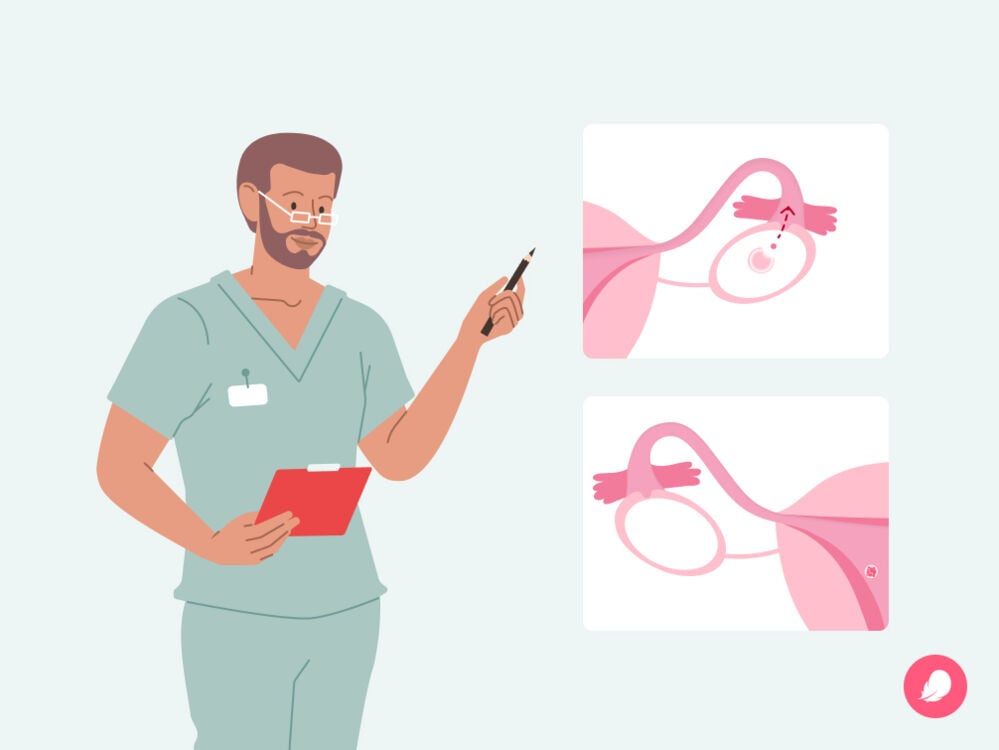
“[Implantation bleeding] typically happens around cycle days 21 to 24, just before a missed period,” says Dr. Flanagan. “Sometimes, implantation is confused with the possible beginning of the menstrual cycle. However, when it’s the start of a period, the cramping gets more constant, and the spotting turns into darker red bleeding.”
So if you’re not sure if it’s implantation bleeding or your period starting, try to be patient. Waiting to see if the bleeding develops into a full flow can be tough, but trust that your body will let you know what’s going on in its own time.
How do I know if it’s ovulation or implantation?
As we’ve seen, both ovulation and implantation can cause light bleeding or spotting (that’s more of a pink-brown discharge than bright red blood) with mild cramps. So how do you tell them apart?
“The biggest giveaway is the timing in the cycle,” says Dr. Flanagan. “Ovulation bleeding happens mid-cycle, whereas implantation bleeding occurs in the final week.”
So, to recap, if you’re midway through your menstrual cycle — which would be around day 14 of an average 28-day cycle — it’s likely to be ovulation bleeding and ovulation pain. But if you’re further into the second half of your cycle and approaching the date of your period, it could be implantation bleeding and implantation cramps.
Confused? Using a cycle tracker like Flo can help you figure out where you are in your cycle and why you might be experiencing certain symptoms. Try the Flo app for free now.
Ovulation bleeding vs. implantation bleeding
There are other, more subtle ways to tell ovulation and implantation bleeding apart aside from when it happens. For example, the color and consistency of the bleeding could help you spot the difference. “Typically, ovulation bleeding is light pink mixed with egg white cervical mucus, whereas implantation spotting is more brown, pink, or light red and mixed with more watery cervical mucus,” says Dr. Flanagan.
If you experience cramping, the location of the pain could be a giveaway too. “Implantation spotting is often reported to coincide with light uterine cramping, whereas ovulation bleeding can be accompanied by discomfort on the side where the ovary has released the egg,” says Dr. Flanagan.
However, these are subtle changes and signs, so try not to worry too much if you don’t think you’ve spotted symptoms of ovulation or implantation.
The easiest way to know if implantation has actually happened is to take a pregnancy test the day after a missed period. You can figure out when this day is by using our period date calculator.
What else can I do?
Since the timing of ovulation vs. implantation is key, knowing when you typically ovulate will make it easier to tell the difference. There are plenty of ovulation-tracking methods out there for you to try.
For example, an ovulation-tracking app like Flo can predict when you’re likely to ovulate based on your unique cycle data. For more information on this and other popular methods, read our guide on simple ways to track ovulation.
Take a quiz
Find out what you can do with our Health Assistant
When to take a pregnancy test
“Anytime from the first day of your missed period is the most accurate time to take a pregnancy test,” says Dr. Flanagan. “That way, implantation has occurred, and the level of pregnancy hormone [called human chorionic gonadotropin or hCG] — which has been rising since implantation — should be detectable in the urine. If the test is taken too early, then there may not be enough hCG to be detected to confirm the pregnancy. This is when a false negative may occur.”
Waiting to take a pregnancy test — often referred to as the “two-week wait” — can be a frustrating time. Some pregnancy tests are designed to cut down that time and can be taken as early as 10 days after fertilization. It can be more accurate to wait until you’ve missed your period, though. So if you get a negative result from one of the early tests but then find your period is late, you should test again.
And remember, if you’ve noticed light bleeding or spotting just before your period is due, it could be implantation bleeding. Needing to pee more often or having aversions to certain foods or smells are other early pregnancy signs that are different from symptoms of premenstrual syndrome.
Being hyper-aware of what’s going on in your body can be anxiety-inducing and even exhausting. So however you choose to track ovulation and pregnancy symptoms, remember to be extra kind to yourself right now.
More FAQs
How do I know if I conceived during ovulation?
The best way to know for certain whether you have conceived is by taking a pregnancy test. Aside from that, the most common and obvious symptom of pregnancy is a missed period. While some tests are designed to be taken earlier than others, the most accurate time to take a pregnancy test is on the first day after a missed period.
Can implantation pain feel like ovulation?
According to Dr. Flanagan, it is “possible” that implantation pain might feel like ovulation. “However, more often, implantation is coupled with uterine cramping, whereas ovulation is typically unilateral pelvic discomfort [i.e., pain on one side of your pelvis] related to the ovulating ovary,” she says.
Why am I cramping a few days after ovulating?
Ovulation pain can last for up to a day or two after ovulation. So if your cramps are happening three or more days past ovulation, it could be another cause of abdominal pain like endometriosis (when tissue similar to the lining of your uterus grows in other parts of your body) or ovarian cysts (fluid-filled sacs on your ovaries).
Cramping a few days after ovulation is unlikely to be caused by implantation, which typically happens at least six days after ovulation. If you’re concerned about any abdominal pain you’re having, don’t hesitate to speak to your doctor about it.


Hey, I'm Anique
I started using Flo app to track my period and ovulation because we wanted to have a baby.


The Flo app helped me learn about my body and spot ovulation signs during our conception journey.


I vividly
remember the day
that we switched
Flo into
Pregnancy Mode — it was
such a special
moment.
Real stories, real results
Learn how the Flo app became an amazing cheerleader for us on our conception journey.
References
“Am I Pregnant?” Cleveland Clinic, my.clevelandclinic.org/health/articles/9709-pregnancy-am-i-pregnant. Accessed 9 May 2024.
“Cervix.” Cleveland Clinic, my.clevelandclinic.org/health/body/23279-cervix. Accessed 9 May 2024.
Charlewood, G. P. “Mittelschmerz or Ovulation Pain.” Suid-Afrikaanse Tydskrif vir Geneeskunde [South African Medical Journal], vol. 32, no. 10, Mar. 1958, pp. 261–62.
“Conception.” Cleveland Clinic, my.clevelandclinic.org/health/articles/11585-conception. Accessed 10 May 2024.
“Endometriosis.” The American College of Obstetricians and Gynecologists, Feb. 2021, www.acog.org/womens-health/faqs/endometriosis.
“Home Pregnancy Tests: Can You Trust the Results?” Mayo Clinic, 23 Dec. 2022, www.mayoclinic.org/healthy-lifestyle/getting-pregnant/in-depth/home-pregnancy-tests/art-20047940.
“Implantation Bleeding.” Cleveland Clinic, my.clevelandclinic.org/health/symptoms/24536-implantation-bleeding. Accessed 9 May 2024.
“Is Implantation Bleeding Common in Early Pregnancy?” Mayo Clinic, 19 Apr. 2022, www.mayoclinic.org/healthy-lifestyle/pregnancy-week-by-week/expert-answers/implantation-bleeding/faq-20058257.
“Luteal Phase.” Cleveland Clinic, my.clevelandclinic.org/health/articles/24417-luteal-phase. Accessed 9 May 2024.
“Menstrual Cycle.” Cleveland Clinic, my.clevelandclinic.org/health/articles/10132-menstrual-cycle. Accessed 9 May 2024.
“Ovulation.” Cleveland Clinic, my.clevelandclinic.org/health/articles/23439-ovulation. Accessed 9 May 2024.
“Ovarian Cysts.” The American College of Obstetricians and Gynecologists, Nov. 2021, www.acog.org/womens-health/faqs/ovarian-cysts.
“Ovulation Pain.” Cleveland Clinic, my.clevelandclinic.org/health/diseases/9134-ovulation-pain-mittelschmerz. Accessed 9 May 2024.
“Pregnancy Tests.” Cleveland Clinic, my.clevelandclinic.org/health/diagnostics/9703-pregnancy-tests. Accessed 9 May 2024.
“Rhythm Method for Natural Family Planning.” Mayo Clinic, 7 Mar. 2023, www.mayoclinic.org/tests-procedures/rhythm-method/about/pac-20390918.
Su, Ren-Wei, and Asgerally T. Fazleabas. “Implantation and Establishment of Pregnancy in Human and Nonhuman Primates.” Advances in Anatomy, Embryology, and Cell Biology, edited by Rodney D. Giesert and Fuller W. Bazer. Springer, 2015, pp. 189–213.
“Symptoms of Pregnancy: What Happens First.” Mayo Clinic, 13 Mar. 2024, www.mayoclinic.org/healthy-lifestyle/getting-pregnant/in-depth/symptoms-of-pregnancy/art-20043853.
Watson, Katie, and Cara Angelotta. “The Frequency of Pregnancy Recognition across the Gestational Spectrum and Its Consequences in the United States.” Perspectives on Sexual and Reproductive Health, vol. 54, no. 2, June 2022, pp. 32–37, https://doi.org/10.1363/psrh.12192.
“What Ovulation Signs Can I Look Out for if I’m Trying to Conceive?” Mayo Clinic, 7 Dec. 2022, www.mayoclinic.org/healthy-lifestyle/getting-pregnant/expert-answers/ovulation-signs/faq-20058000.
Witt, Barry. “Trying to Get Pregnant? Here’s When to Have Sex.” The American College of Obstetricians and Gynecologists, Aug. 2023, www.acog.org/womens-health/experts-and-stories/the-latest/trying-to-get-pregnant-heres-when-to-have-sex. Accessed 9 May 2024.
History of updates
Current version (13 May 2024)
Published (13 May 2024)
In this article
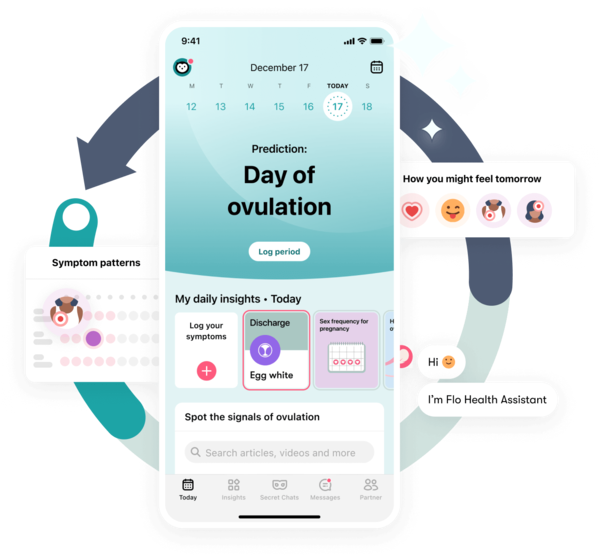
Get your personal guide to fertility
-
Learn how to read your body's ovulation signals
-
Find daily conception tips from our experts
-
Chat with others who are trying to get pregnant




